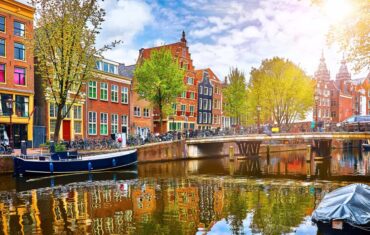Rome, a city steeped in history, unfolds its layers across centuries. Within moments, you can transition from modern structures to the awe-inspiring remnants of antiquity, classical architectural wonders, such as Doric columns dating back to the Roman Republic, Renaissance palaces crafted by Michelangelo, or charming piazzas adorned with Bernini’s Baroque fountains.
- Walking tours like Ultimate Free Walking Tour offer budget-friendly ways to explore Rome, providing insights into the city’s history. Take Walks offers in-depth guided tours, including skip-the-line access to famous attractions like the Sistine Chapel.

- The Colosseum, a monumental Roman amphitheater, once held 50,000 spectators. Buy tickets at the nearby Palatine Hill entrance or online for access to this iconic historical site.

- The Roman Forum, once the heart of the ancient world, features ancient ruins and temples. It’s a historic treasure, though it requires some imagination to envision its bustling past.

- Vatican Museums house incredible art collections, including Michelangelo’s Sistine Chapel ceiling. Avoid morning crowds, and consider a guided tour like Take Walks.
- St. Peter’s Square and Basilica, designed by renowned artists, stand as impressive symbols of the Catholic Church. Explore the Vatican’s spiritual and artistic treasures.

- Campo de’ Fiori hosts a lively market in the morning, with Giordano Bruno‘s statue at its center, while nearby Trastevere offers charming streets and cafes.

- Santa Maria del Popolo boasts Caravaggio’s masterpieces, drawing art enthusiasts. The Chigi chapel, designed by Raphael and completed by Bernini, adds to its allure.

- Piazza Navona, a popular square, showcases Bernini’s Fountain of the Four Rivers and vibrant street life, particularly during Christmas markets in winter.

- Testaccio, historically linked to food, offers a taste of local cuisine with its roots in the district’s slaughterhouse workers.

- Villa Borghese‘s manicured gardens surround the Galleria Borghese, housing a remarkable art collection. Book tickets in advance and explore this cultural gem.

- Santa Maria della Concezione’s crypt, known as I Capuccini, displays thousands of bones and macabre arrangements. It’s a unique and eerie experience.

- The Spanish Steps, despite recent sitting restrictions, remain an iconic spot for leisurely strolls and gelato.

- Trevi Fountain dazzles visitors with its waterworks, though it’s best enjoyed early or late to avoid crowds.

- Ara Pacis, an altar celebrating Emperor Augustus’s peace, offers historical insights into ancient Rome.

- In Vincoli houses chains that supposedly held St. Peter and Michelangelo‘s sculpture of Moses.

- The Baths of Caracalla, a massive ancient thermal bath complex, provide a glimpse into Roman bathing culture.

- The Pantheon, an architectural marvel, once a temple to all gods, features a stunning domed interior and historic significance.

- Santa Maria sopra Minerva, Rome’s only Gothic church, houses artwork, including Michelangelo’s Christ holding the Cross.

- The Appian Way, an ancient Roman road, is now a peaceful park filled with historic ruins.

- San Giovanni in Laterano, one of Rome’s major basilicas, holds religious and historical significance.

- Trastevere, a picturesque neighborhood, is known for its narrow streets, cafes, and vibrant atmosphere.

- Santa Croce in Gerusalemme’s floor, once covered in soil from Jerusalem, holds relics and unique artwork.

- Castel Sant’Angelo, a mausoleum turned fortress, offers panoramic views of Rome.

- Santa Maria della Vittoria features Bernini’s dramatic sculpture, The Ecstasy of St. Teresa, known for its artistic and interpretive significance.

5 FAQs About Rome
- What is the history of Rome?
Rome has a rich and storied history dating back over 2,700 years. It was founded in 753 BC and went on to become the capital of the Roman Republic and later the Roman Empire, which was one of the most powerful and influential civilizations in history. Rome played a crucial role in the development of Western civilization, with its contributions in law, governance, engineering, art, and culture. - What are the must-visit attractions in Rome?
Rome is home to numerous iconic landmarks and attractions. Some of the must-visit places include the Colosseum, Roman Forum, Vatican City (including St. Peter’s Basilica and the Vatican Museums), the Pantheon, the Trevi Fountain, the Spanish Steps, and the Roman Catacombs, among others. The city is also known for its beautiful parks, such as Villa Borghese, and charming neighborhoods like Trastevere. - What is the cuisine like in Rome?
Roman cuisine is known for its simplicity and use of fresh, high-quality ingredients. Some popular Roman dishes include pasta dishes like Carbonara, Cacio e Pepe, and Amatriciana. You’ll also find delicious thin-crust Roman-style pizzas, supplì (deep-fried rice balls), and a variety of gelato flavors. Wine is a significant part of Roman dining, and you can enjoy local wines like Frascati and Castelli Romani. - How do I get around Rome?
Rome has an extensive public transportation system that includes buses, trams, and a metro system. The Rome Metro, with its three lines (A, B, and C), is the most convenient way to navigate the city quickly. Additionally, many of Rome’s historical sites are within walking distance of each other in the city center, making it a great city for exploring on foot. - What is the best time to visit Rome?
The best time to visit Rome is typically during the spring (April to June) and fall (September to October) when the weather is pleasant, and the tourist crowds are not as overwhelming as in the peak summer months. However, Rome can be visited year-round, and each season has its unique charm. Winters are milder than in many other parts of Europe, making it a good option for off-season travel.






